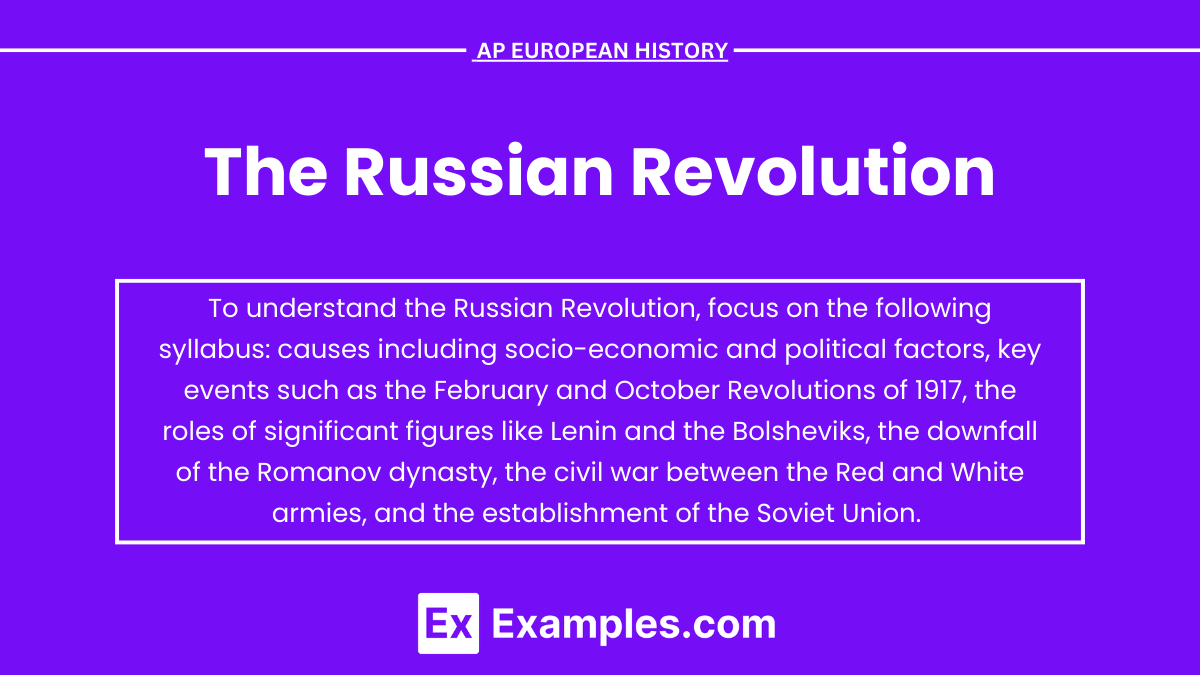The Russian Revolution of 1917 was a landmark event that dismantled the centuries-old Tsarist autocracy and led to the rise of the Soviet Union. Triggered by widespread social, economic, and political discontent, the revolution consisted of two key phases: the February Revolution, which overthrew Tsar Nicholas II, and the October Revolution, which brought the Bolsheviks to power under Lenin. This revolution, crucial to AP European History, not only reshaped Russian society but also had profound global impacts, influencing future communist movements worldwide.
Learning Objectives
By studying the Russian Revolution for the AP European History exam, you should aim to understand the social, political, and economic causes leading to the revolution, including the impact of World War I. Analyze the key events of the February and October Revolutions, identify major figures such as Lenin and Trotsky, and examine the resulting shifts in power. Assess the outcomes, including the civil war, establishment of the Soviet Union, and the global influence of communist ideology. Recognize the revolution's long-term effects on 20th-century history and international relations.
Russian Revolution and Causes
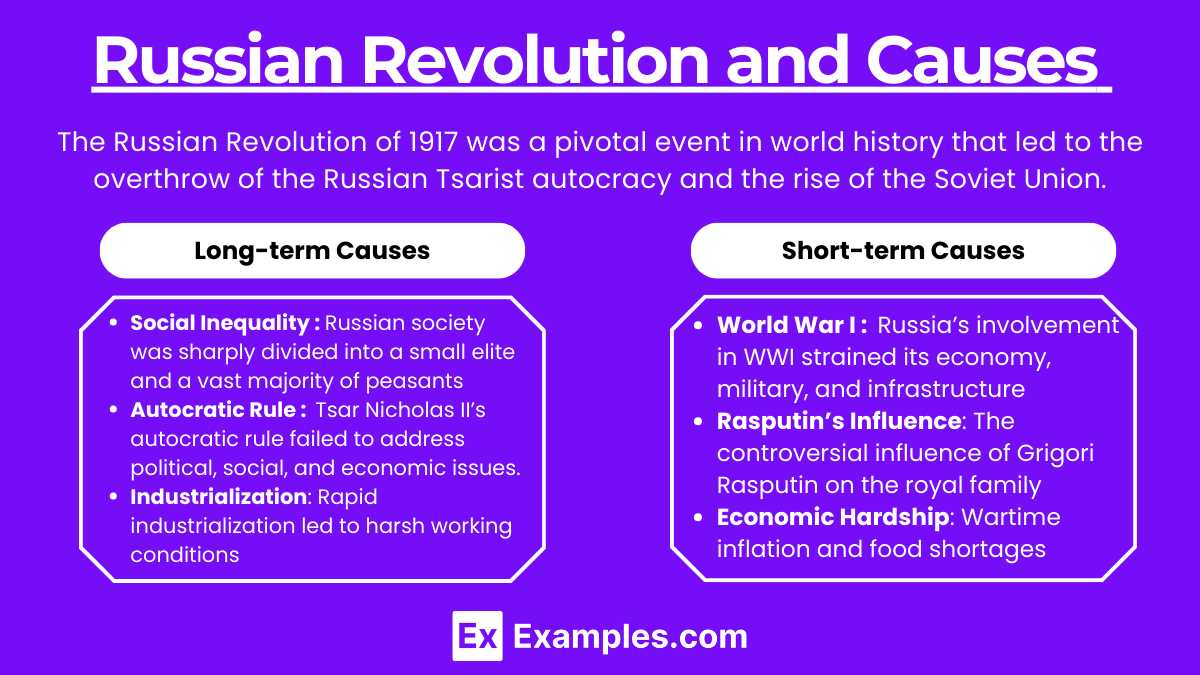
The Russian Revolution of 1917 was a pivotal event in world history that led to the overthrow of the Russian Tsarist autocracy and the rise of the Soviet Union. It consisted of two major phases: the February Revolution and the October Revolution.
Causes of the Russian Revolution
Long-term Causes
Social Inequality: Russian society was sharply divided into a small elite and a vast majority of peasants and industrial workers living in poverty.
Autocratic Rule: Tsar Nicholas II’s autocratic rule failed to address political, social, and economic issues. The lack of political freedom and repression of dissent fueled widespread discontent.
Industrialization: Rapid industrialization led to harsh working conditions, low wages, and poor living standards for urban workers, exacerbating social tensions.
Short-term Causes
World War I: Russia’s involvement in WWI strained its economy, military, and infrastructure, leading to severe shortages and widespread suffering.
Rasputin’s Influence: The controversial influence of Grigori Rasputin on the royal family discredited the monarchy.
Economic Hardship: Wartime inflation and food shortages caused widespread starvation and unrest.
February Revolution (March 1917)
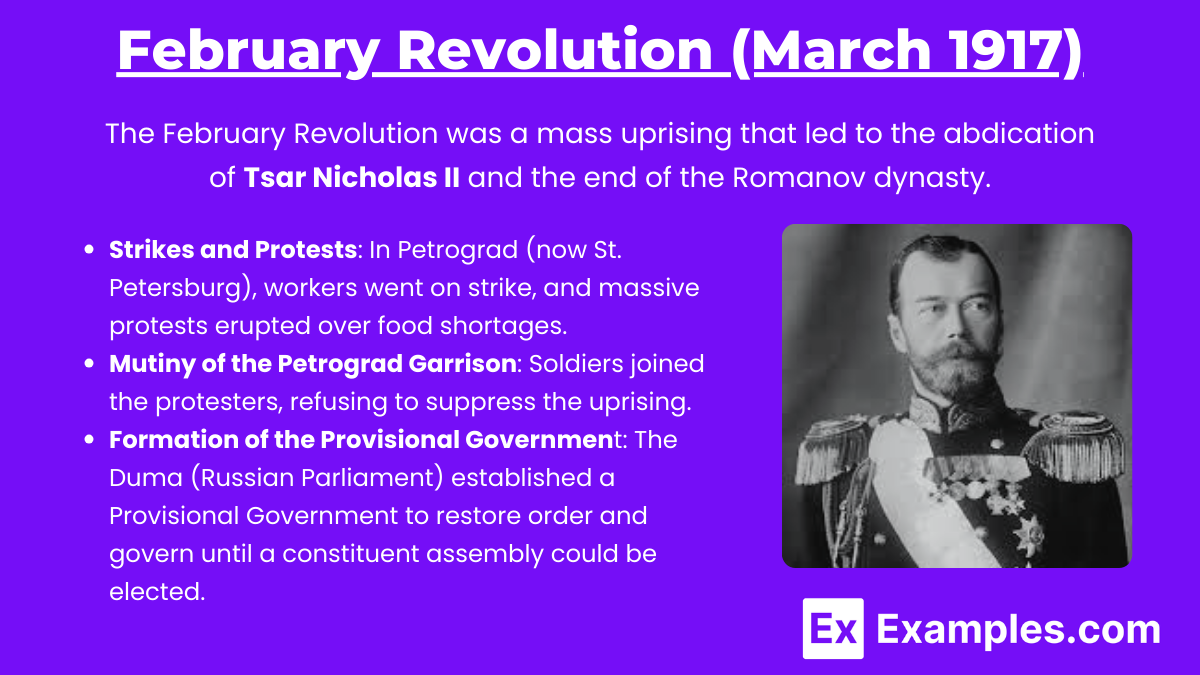
The February Revolution was a mass uprising that led to the abdication of Tsar Nicholas II and the end of the Romanov dynasty.
Key Events
Strikes and Protests: In Petrograd (now St. Petersburg), workers went on strike, and massive protests erupted over food shortages.
Mutiny of the Petrograd Garrison: Soldiers joined the protesters, refusing to suppress the uprising.
Formation of the Provisional Government: The Duma (Russian Parliament) established a Provisional Government to restore order and govern until a constituent assembly could be elected.
Outcomes
Abdication of Tsar Nicholas II: The Tsar abdicated, ending centuries of Romanov rule.
Dual Power: Power was shared between the Provisional Government and the Petrograd Soviet, a council representing workers and soldiers.
October Revolution (November 1917)
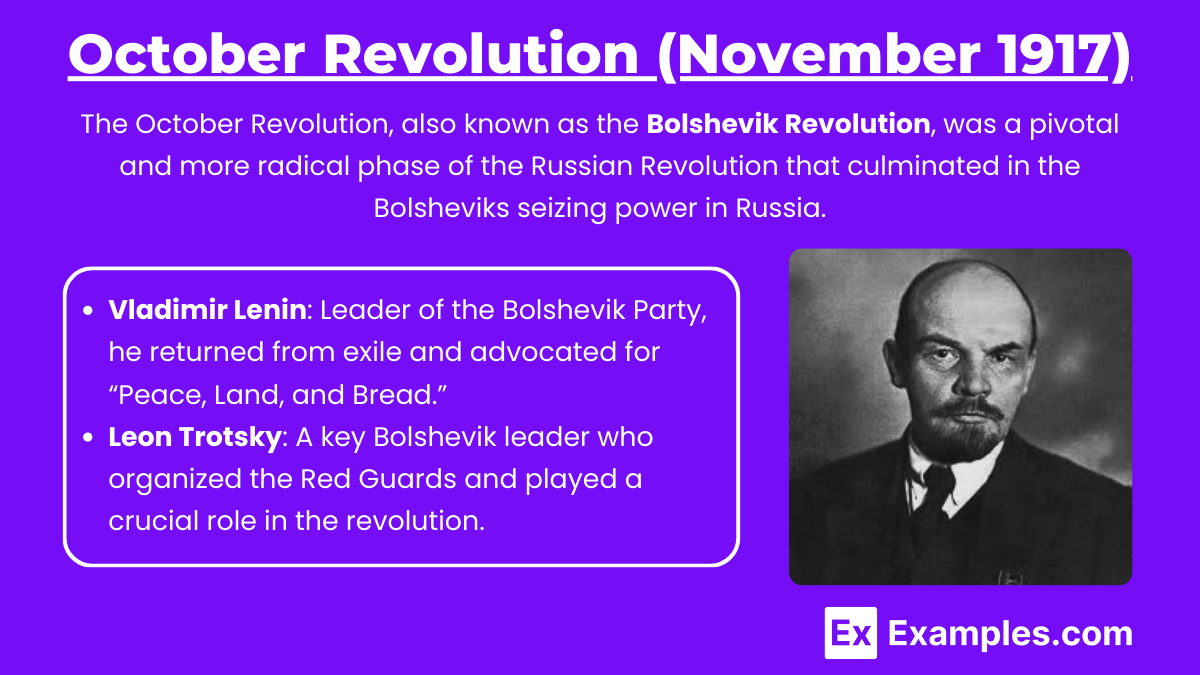
The October Revolution, also known as the Bolshevik Revolution, was a pivotal and more radical phase of the Russian Revolution that culminated in the Bolsheviks seizing power in Russia. It marked the overthrow of the Provisional Government and led to the establishment of a communist state. The revolution was driven by widespread discontent with the Provisional Government's inability to address critical issues like land reform, food shortages, and ongoing involvement in World War I.
Key Figures
Vladimir Lenin: Leader of the Bolshevik Party, he returned from exile and advocated for “Peace, Land, and Bread.”
Leon Trotsky: A key Bolshevik leader who organized the Red Guards and played a crucial role in the revolution.
Key Events
Storming of the Winter Palace: On October 25, 1917, Bolshevik forces stormed the Winter Palace in Petrograd, arresting members of the Provisional Government.
Seizure of Key Institutions: Bolsheviks took control of government buildings, telegraph stations, and the state bank.
Outcomes
Bolshevik Control: The Bolsheviks established a new government, the Council of People’s Commissars, with Lenin as its head.
Decrees on Land and Peace: Lenin issued decrees to redistribute land to peasants and withdraw Russia from WWI (Treaty of Brest-Litovsk).
Civil War and Consolidation of Power (1917-1922)
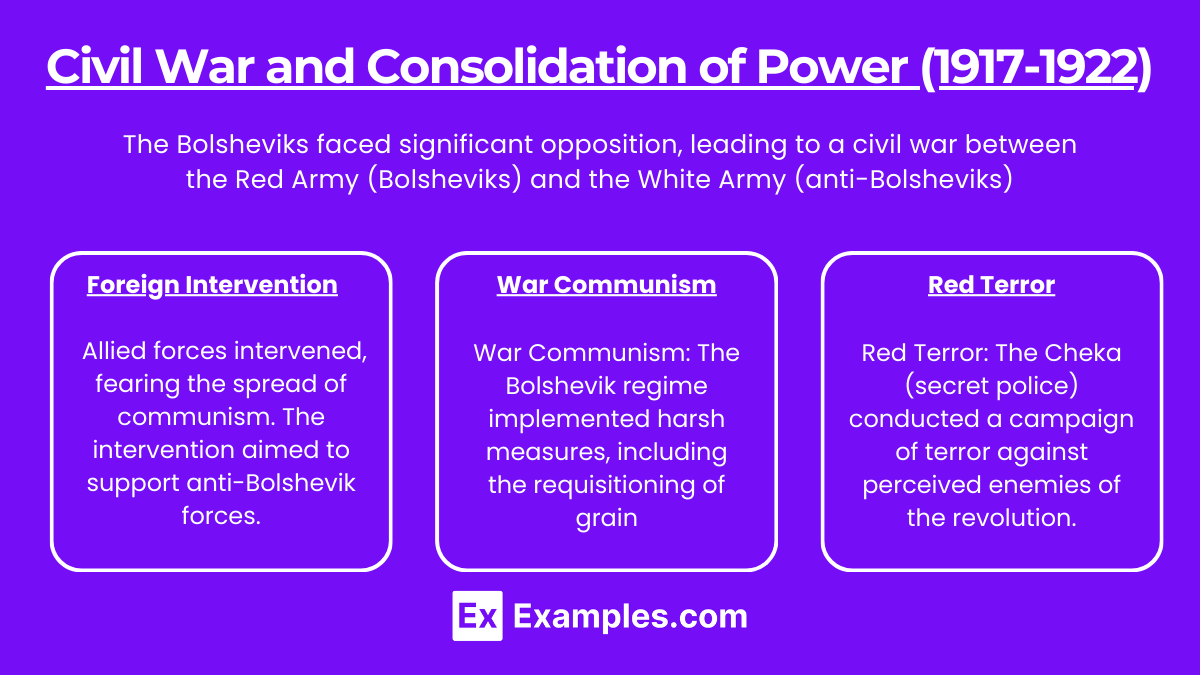
The Bolsheviks faced significant opposition, leading to a civil war between the Red Army (Bolsheviks) and the White Army (anti-Bolsheviks).
Key Points
Foreign Intervention: Allied forces intervened, fearing the spread of communism. The intervention aimed to support anti-Bolshevik forces and protect their own interests in the region.
War Communism: The Bolshevik regime implemented harsh measures, including the requisitioning of grain and nationalization of industry, to support the war effort.
Red Terror: The Cheka (secret police) conducted a campaign of terror against perceived enemies of the revolution.
Outcome
Bolshevik Victory: By 1922, the Red Army had defeated the White forces and secured Bolshevik control over Russia.
Formation of the USSR: In 1922, the Union of Soviet Socialist Republics (USSR) was established, marking the beginning of a new socialist state.
Impact of the Russian Revolution
Political Impact
End of Monarchy: The revolution ended centuries of autocratic rule in Russia.
Rise of Communism: The establishment of a communist government inspired communist movements worldwide.
Social and Economic Impact
Land Redistribution: Land was redistributed to peasants, significantly altering rural society.
Economic Changes: The nationalization of industry and centralized economic planning marked a significant shift from capitalism to socialism.
Global Impact
Ideological Influence: The success of the Bolsheviks encouraged the spread of communist ideology globally.
Cold War: The establishment of the Soviet Union laid the groundwork for the ideological conflict between the East (Soviet bloc) and the West (Western bloc) during the Cold War.
Examples
Example 1: The February Revolution (March 1917)
Example: People in Russia were unhappy with their government. They were suffering from food shortages and the hardships of World War I. In February 1917, workers went on strike, and soldiers joined them. This led to Tsar Nicholas II stepping down from power.
Example 2. The October Revolution (November 1917)
Example: Later in the same year, the Bolsheviks, led by Vladimir Lenin, took control of the government. They promised "peace, land, and bread" to the people. This revolution resulted in the Bolsheviks overthrowing the provisional government.
Example 3. The End of the Romanov Dynasty
Example: The Russian Revolution led to the end of the Romanov dynasty, which had ruled Russia for over 300 years. Tsar Nicholas II and his family were eventually executed by the Bolsheviks in 1918.
Example 4. The Civil War (1917-1922)
Example: After the Bolsheviks took power, a civil war broke out between the Red Army (Bolsheviks) and the White Army (anti-Bolsheviks). The civil war lasted until 1922, with the Red Army emerging victorious and solidifying Bolshevik control over Russia.
Example 5. The Formation of the Soviet Union (1922)
Example: Following their victory in the civil war, the Bolsheviks established the Soviet Union in 1922. This new state was based on communist principles and marked the beginning of a new era in Russian and world history.
Multiple Choice Questions
Question 1:
What was one of the primary causes of the Russian Revolution in 1917?
A. The Industrial Revolution
B. The assassination of Archduke Franz Ferdinand
C. Widespread dissatisfaction with the Tsarist regime
D. The Treaty of Versailles
Answer: C. Widespread dissatisfaction with the Tsarist regime
Explanation: The Russian Revolution was largely fueled by widespread dissatisfaction with the autocratic Tsarist regime. The oppressive policies of Tsar Nicholas II, combined with the harsh socio-economic conditions, led to mass unrest. The people, including workers, peasants, and soldiers, demanded better living conditions, more political freedom, and an end to the war. This discontent ultimately culminated in the overthrow of the Tsarist regime in 1917.
Question 2:
Which event marked the beginning of the Bolshevik control over Russia?
A. The February Revolution
B. The signing of the Treaty of Brest-Litovsk
C. The October Revolution
D. The Russian Civil War
Answer: C. The October Revolution
Explanation: The October Revolution, also known as the Bolshevik Revolution, marked the beginning of Bolshevik control over Russia. It took place in October 1917 (Julian calendar; November in the Gregorian calendar) when the Bolsheviks, led by Vladimir Lenin, overthrew the Provisional Government. This event was pivotal in establishing a socialist government and led to the creation of the Soviet Union.
Question 3:
What was the significance of the Treaty of Brest-Litovsk?
A. It ended World War I.
B. It led to the abdication of Tsar Nicholas II.
C. It ended Russia's involvement in World War I.
D. It started the Russian Civil War.
Answer: C. It ended Russia's involvement in World War I.
Explanation: The Treaty of Brest-Litovsk, signed in March 1918, was a peace treaty between the new Bolshevik government of Soviet Russia and the Central Powers (Germany, Austria-Hungary, Bulgaria, and the Ottoman Empire). This treaty ended Russia's involvement in World War I, allowing the Bolsheviks to focus on consolidating power internally and dealing with the ensuing Russian Civil War. The treaty came at a significant cost, as Russia ceded large territories to the Central Powers.

